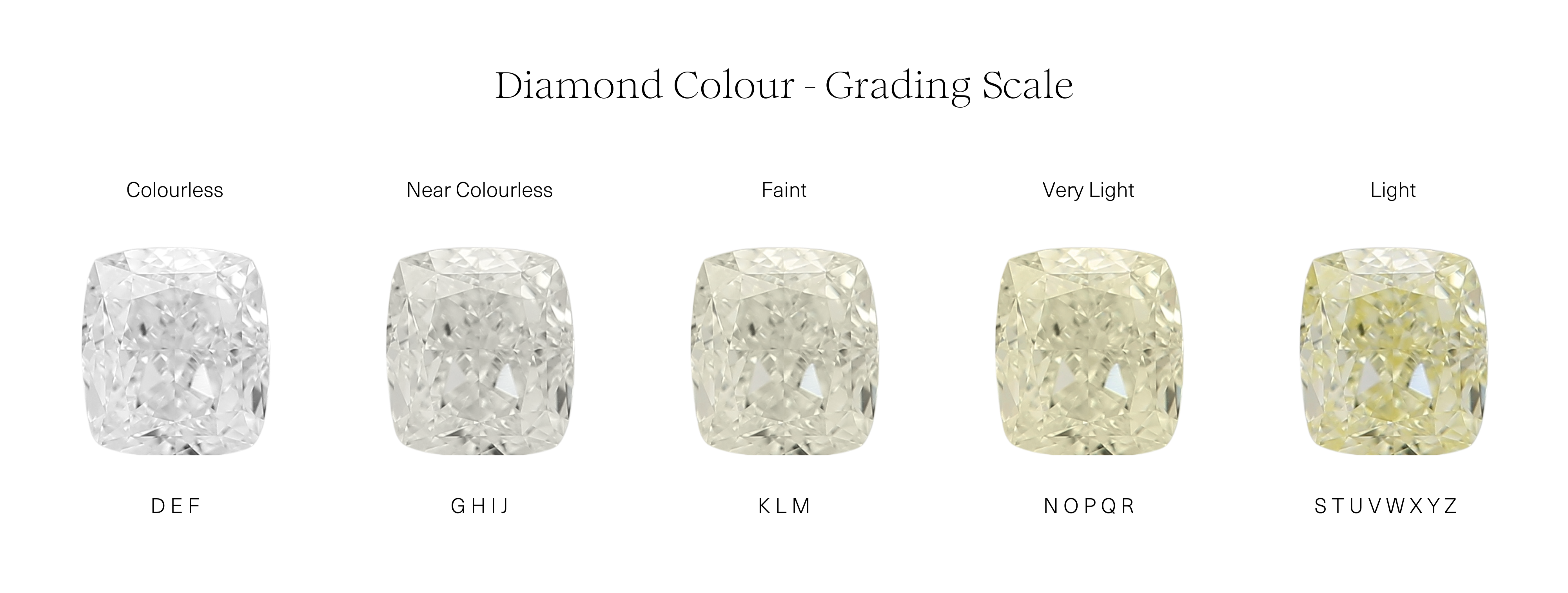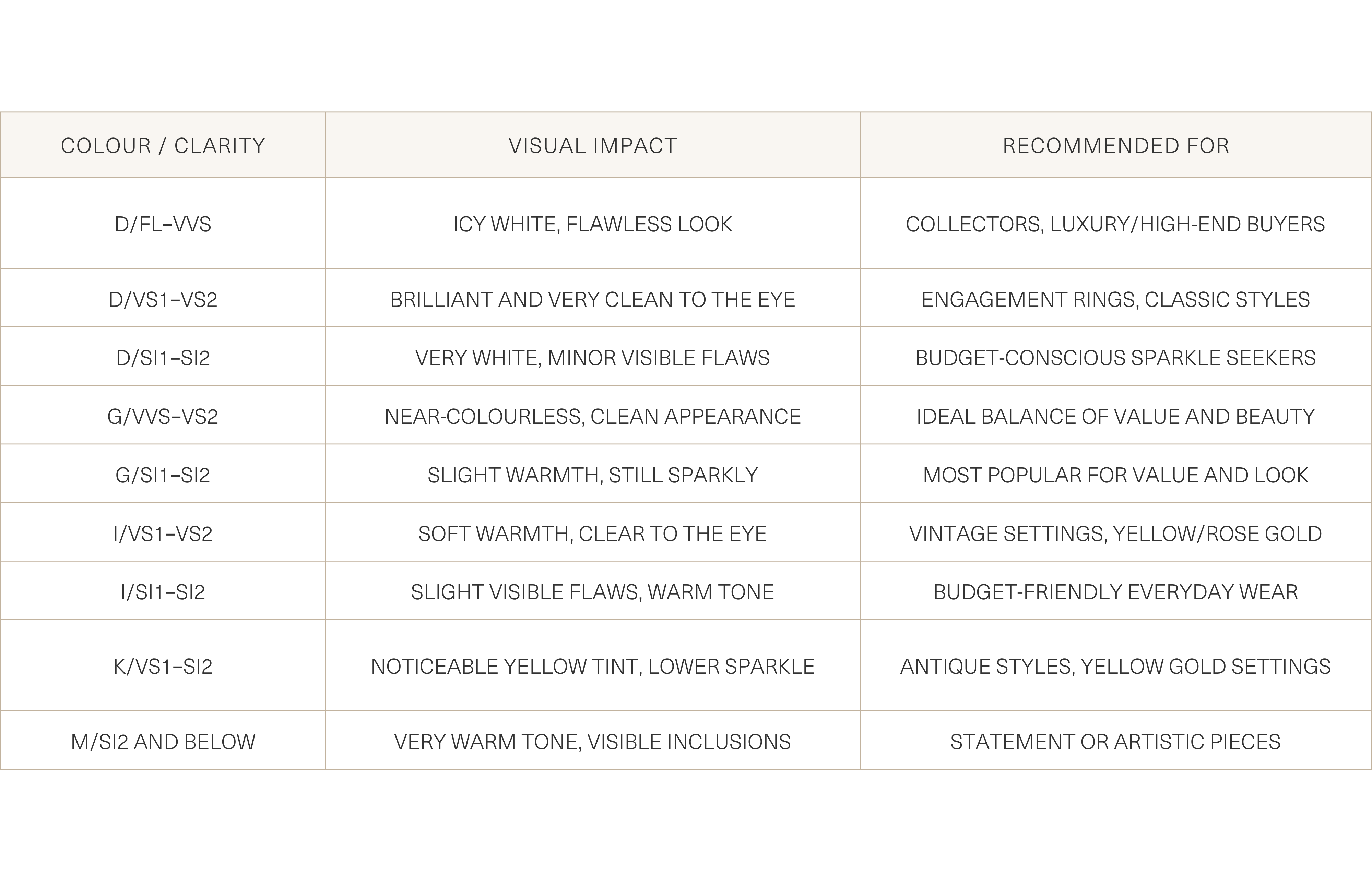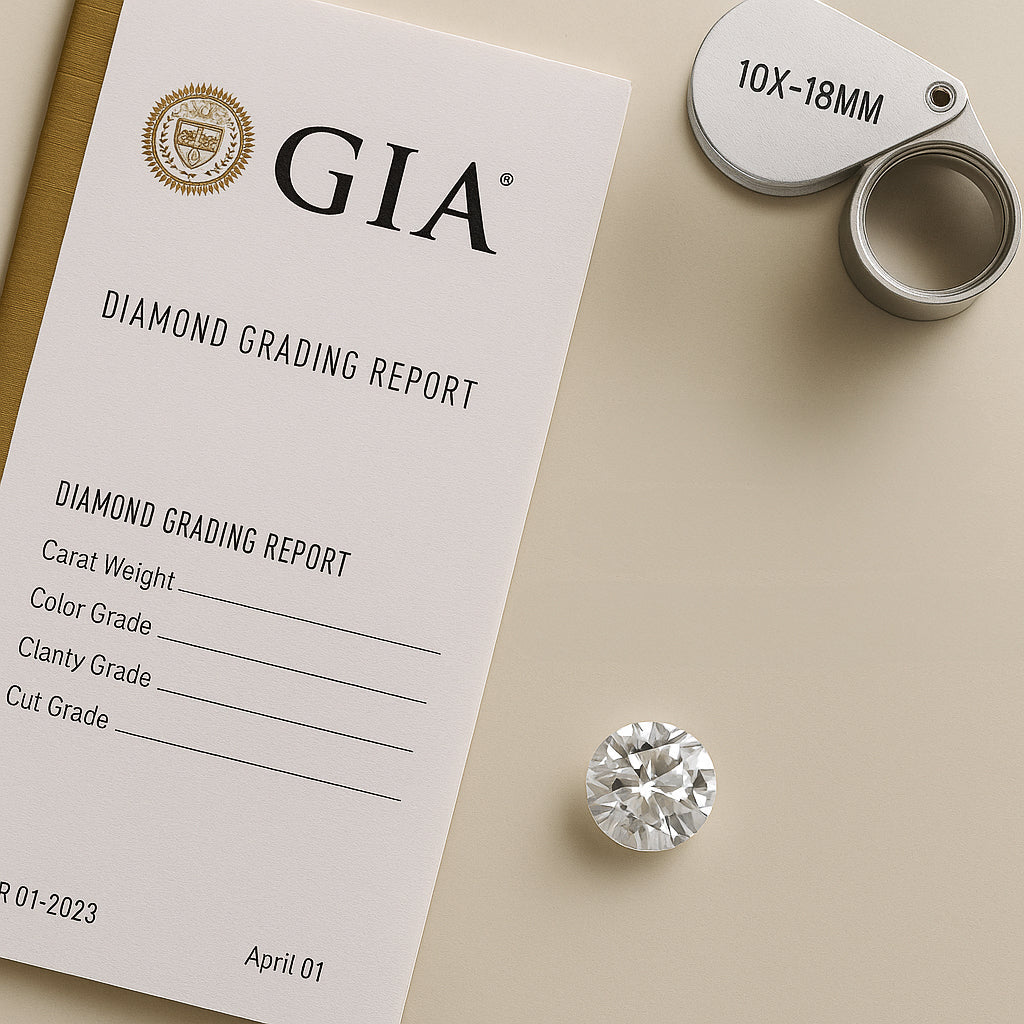If you’ve just started shopping for diamond jewellery, you may be surprised to learn that when we speak about the colour of diamonds, we are referring to the absence of colour, rather than pink, blue and yellow diamonds. The ‘best’ diamonds are considered colourless, and to the naked eye, these appear as the crystal-clear white diamonds that dazzle onlookers everywhere. These will have what’s called a D colour rating—generally considered the best colour for lab-grown diamond rings and other jewellery.
Find out everything you need to know about lab-grown diamond colours in our complete guide.
What Does Colour Mean in Lab-Grown Diamonds?
Colour is one of the four ‘Cs’ of diamonds, along with cut, clarity and carat weight.
- Cut: Refers to how the diamond is shaped and, therefore, how much light it lets in.
- Clarity: How many inclusions (blemishes) the diamond has.
- Carat: This refers to the weight of the diamond.
- Colour: Another marker referring to whether a diamond is completely colourless or has brown or yellow tints.
What is the Lab Diamond Colour Chart?
Lab-grown diamond colour refers to the presence or absence of yellow or brown tints caused by trace elements, mainly nitrogen, during the growth process. Like earth-mined diamonds, those created in labs are graded for colour on a scale that measures how colourless they appear. The less colour present, the rarer and typically more valuable the diamond.
The lab diamond colour chart is used to assess the value of the diamond. As mentioned above, the colour falls under the 4 Cs of diamonds, which were developed by the Gemological Institute of America (GIA) and serve as a benchmark for the entire industry.
The lab-grown diamond colour chart ranges from D (the most colourless) right down to Z, as stipulated by the GIA. Fyne uses D-F coloured lab-grown diamonds, which are generally more valuable, but that’s not to say that lower-graded coloured diamonds don’t have their advantages—they can be appealing in vintage jewellery and are also more financially accessible.
Understanding the Lab-Grown Diamond Colour Chart
The colour scale for lab-grown diamonds mirrors that of natural diamonds, ranging from D (colourless) to Z (noticeable yellow or brown hues). This standardised scale, developed by the Gemological Institute of America (GIA), helps buyers understand how white or tinted a diamond appears, with diamonds closer to D offering a brighter, icier appearance.
When shopping for diamonds, a good rule of thumb is first to set your budget. When you are familiar with the four Cs of diamonds, you can decide which is more important and determine if you’re happy to sacrifice the cut for colour and carat, or carat for clarity and colour, etc. There’s no right or wrong here—your priorities are yours. We want to help you make an informed decision.
Lab-grown Diamond Colour Chart: from D to Z explained
Lab-grown diamonds are graded on the same colour scale as natural diamonds, ranging from D (colourless) to Z (light yellow or brown). This scale reflects the degree of tint present in a diamond when viewed under controlled lighting and against a white background. The differences between each grade can be subtle to the untrained eye, but they have a significant impact on appearance and price.
Lab Diamond Colour Chart

Lab-Grown Diamond Colour Scale
- D–F (Colourless): These diamonds show no noticeable colour. They appear icy white and are prized for their pure, crisp brilliance. D is the rarest and most expensive grade.
- G–J (Near Colourless): These diamonds have a slight warmth that’s often imperceptible once set, especially in yellow or rose gold. They offer excellent value while still appearing white to most people.
- K–M (Faint Colour): A noticeable yellow or brown tint becomes visible, especially in larger stones or in white metal settings. These grades can work beautifully in vintage or antique-style rings.
- N–Z (Very Light to Light Colour): The colour is clearly visible and may be desirable for unique or characterful pieces. These diamonds are more affordable and often chosen for creative or alternative designs.
Did you know? The metal of the ring setting can affect how the diamond colour appears—for instance, slightly tinted diamonds may look whiter when set in yellow or rose gold.
Colour Vs. Clarity: How They Interact in Lab Diamonds
While colour refers to hue, clarity measures the presence of internal or external imperfections (inclusions and blemishes). A diamond with excellent clarity but poor colour can appear less brilliant than a slightly included diamond with a higher colour grade. The interplay between these factors impacts overall sparkle and visual appeal.
In a nutshell:
- Colour refers to how much tint (usually yellow or brown) is visible in the diamond. This affects the overall tone and how "white" the diamond looks. The less colour, the higher the grade, with D being completely colourless and Z showing a noticeable hue.
- Clarity relates to the internal (inclusions) and external (blemishes) imperfections in the diamond. It affects transparency and how clean the diamond looks under close inspection. In general, fewer and smaller inclusions typically result in a higher clarity grade, with FL (flawless) being the highest grade on the scale.
Together, they influence brilliance, or the extent to which a diamond reflects and refracts light.
Although high clarity is desirable, it doesn't always mean the diamond will appear more brilliant or attractive. A diamond with a tiny inclusion (VS1 or SI1 clarity) but a higher colour grade (such as F or G) may sparkle more and appear cleaner to the naked eye.
When balancing your budget, it’s often better to prioritise a better colour grade over flawless clarity, unless you’re buying for investment or close-up inspection—especially since many inclusions are invisible without a jeweller’s loupe.
What is the Best Colour for Lab-Grown Diamond Jewellery?
The "best" colour depends on personal preference and budget. For a classic, bright white look, grades D to F are ideal. However, many buyers opt for G or H to balance appearance and value, as they still appear colourless to most untrained eyes, especially once set in jewellery.
Lab-Grown Diamond Colour and Clarity Chart
The chart below combines colour and clarity grades, aiming to provide a visual reference to help you assess diamond quality.
To understand the lab-grown diamond colour and clarity chart, we’ve included some example combinations of colour and clarity. Remember, colour ranges from D to Z, with D being the highest score. Fyne uses D-F colour diamonds.
Clarity refers to the imperfections visible to the naked eye or under a microscope. You can see a visual explanation in this article, but as a guideline, here are the clarity grades briefly explained:
- FL is Flawless, with no imperfections
- VVS is Very, Very Slightly included (some minor imperfections under 10x magnification)
- VS1 and VS2 are Very Slightly included (a few imperfections that may be visible to the trained naked eye
- SI1 and SI2 are Slightly Included and will have some imperfections that may be visible to the naked eye
- I stands for ‘Included’, which essentially means the diamond has visible imperfections.
This chart illustrates various combinations of colour and clarity, their visual appearance, and the circumstances under which a buyer may seek a specific combination.

How to Choose the Right Diamond Colour
Choosing the right lab-grown diamond colour isn’t just about technical grades—it’s also about how the stone will look and feel on you or the person who will wear it. Your personal taste, the metal of the setting, and even your skin tone can all influence which colour grade will be the most flattering and visually pleasing.
Cooler tones (D to F)
- Completely colourless and tend to pair best with white metals like platinum or white gold.
- These combinations create a sleek, modern, and crisp appearance—perfect for minimal, contemporary styles or those seeking the brightest, iciest sparkle.
- Cooler diamonds tend to look striking on people with pink or neutral undertones.
Warmer tones (G to J and below)
- These tones have a subtle hint of yellow or warmth, which can be beautifully enhanced when set in yellow or rose gold.
- The metal softens the tint, making the diamond appear whiter by contrast. This makes slightly tinted diamonds ideal for vintage-inspired or romantic settings, and a smart way to maximise budget without sacrificing visual impact.
- Warmer diamonds can complement olive or golden skin beautifully.
You should also consider where and how the diamond will be worn. If it’s a ring for daily wear, slightly lower colour grades may be more forgiving over time and under varying lighting conditions. For statement or occasional pieces, higher grades might be worth the splurge for maximum brilliance under evening lights.
Ultimately, the "right" colour is the one that makes you feel good when you wear it. There are no strict rules, but trying on a few options in natural light can help you get a feel for what suits you best.
Final Thoughts
Choosing a lab-grown diamond is more than just picking a stone—it’s about finding the right balance of beauty, meaning, and practicality. While lab-grown diamond colour is often thought of as one of the most important aspects, it’s really just one piece of the puzzle.
Understanding the colour scale—from icy D-grade diamonds to the warm charm of lower-grade stones—empowers you to make choices that suit your personal style, budget, and the setting in which the diamond will be worn. There’s no one-size-fits-all answer—just what works best for you.
By getting to grips with the four Cs—colour, cut, clarity, and carat—you’re already on the path to making a thoughtful and informed purchase. Lab-grown diamonds offer exceptional value and beauty, and with a clear understanding of how colour and clarity interact, you can prioritise what matters most to you.
Remember, the “best” diamond isn’t necessarily the highest grade—it’s the one that makes you feel confident, happy, and entirely yourself every time you wear it.




